Hi there, all of you Ann the Gran readers. Welcome back to LaRueSews-quilts. This is a bright and sunny day in east central, Alabama. It is, however a bit chilly outside. But I guess that’s better than cold, cloudy and rainy.
I have said before, and I’d like to say again that I am not an expert. I am not a quilting teacher, though I have taught a few classes. My purpose here is to tell you about the knowledge I have of quilting. You may take or leave whatever you wish. There are no quilt police, so do it your way. But it is good to have some basic knowledge from someone who has learned from years of trial and error. You will make mistakes, just as in ME. But you will learn from every mistake you make. Just a thought here. . .it wouldn’t hurt to keep a notebook of mistakes so you will remember how to fix the disasters, no matter how large or small.
There is a rather major/minor area that I haven’t talked about yet that some of you would probably like to try. But since I have never been good with triangles, I’ll just tell you what I know. Triangles, half triangle, and quarter triangles involve math and a good general knowledge of rotary cutting. It’s a good idea to either take a class, join a guild where basic quilting is taught or buy a really good book. I have steered clear of triangles, most of the time, unless the cutting instructions leave no question at all about how to do them. Or, if the instructions include templates for cutting the triangles.
I will see if I can take you through some basic knowledge of triangles. The most used shape in quilting is the square, with triangles a close second. Triangles can be cut in two ways. The most common is cutting half-square triangles. This triangle is made by cutting a square one time, on the diagonal, from one corner, to the opposing corner. This triangle has two short sides, or legs, that are cut on the straight grain.

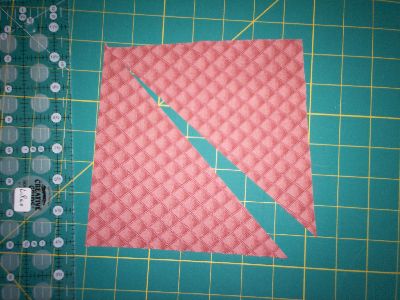
The second triangle method is called the quarter-square triangle. They are cut quickly, by cutting a square twice, in opposing diagonals, yielding four triangles. This triangle is used when the straight grain side of the triangle is on the edge of the quilt. Since the straight grain is on the long side of the triangle, the edge does not stretch as with a triangle that is cut on the bias.
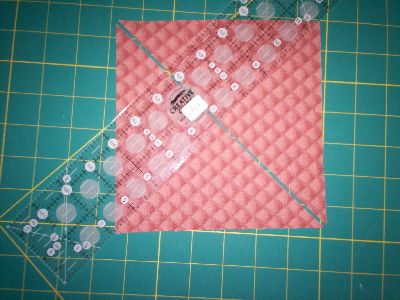
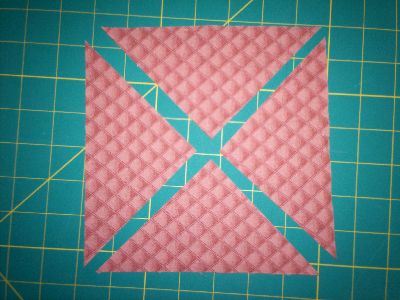
The basic measurement for cutting triangles is as follows. Cutting a square-the finished measurement, plus ½ inch. Cutting a half-square triangle-finished size plus 7/8 inch. Cutting the quarter square triangle- finished measurement plus 1 1/4 inch.
All -In-One Quilter’s Reference Tool, by C & T Publishing is one of my favorite references for most of the quilting techniques that I use and many others. A method for sewing and cutting many half square triangles is shown on page 44 of this book. It can be a quick and handy way to making triangles for block that require half square triangles. Precise marking, sewing and cutting are essential to their success. If you are a quilter, this book is invaluable. I probably use this book more than any other book that I own.
As with any other piecing method, pressing is important. Press with a dry iron, especially triangles. Since triangles have bias edges, they are prone to stretching and distortion. Steam pressing the seams of triangles makes the stretch permanent, and thus may distort the finished seam. Press the seam toward the darker fabric. Don’t press the seams open. When all seams are pressed toward the darker fabric, it is much more likely that the block, when assembled, will have less bulking on seams at the connecting points.
If the seams are pressed open, it is easier for the seam to pop open at the seam with stress. Also, if seams are pressed open, it leaves a weaker space that can allow the batting in a finished seam to migrate through the seam line.
Migration happens when the batting fibers between the layers of a quilt come through the weave of the fabric, or through the seam lines. On a quilt with dark fabrics, this migration will show as unsightly “pilling” on the surface of the quilt fabric. This has happened to one of my favorite quilts. Here, I show the quilt itself and then a close-up of the pilling on this quilt. This probably happens somewhat on all quilts, but it shows up the most on dark colors. It can be avoided by using black batting in quilts that are dark all over, but would show us as gray on light or pastel colors. I have never used black batting, however.
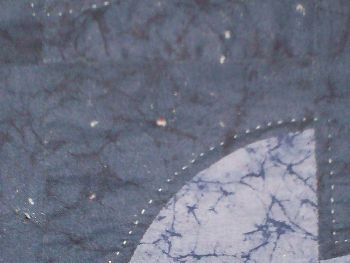
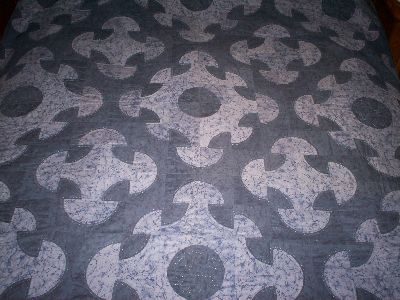
I want you all to know that I have been doing some ME. I read Pat’s blog about Free Standing Lace. FSL has always intrigued me and I really enjoyed her giving us lots of ideas about how to do FSL successfully. I made this angel before Christmas. I enjoyed her so much that I didn’t pack her away with the other Christmas stuff.
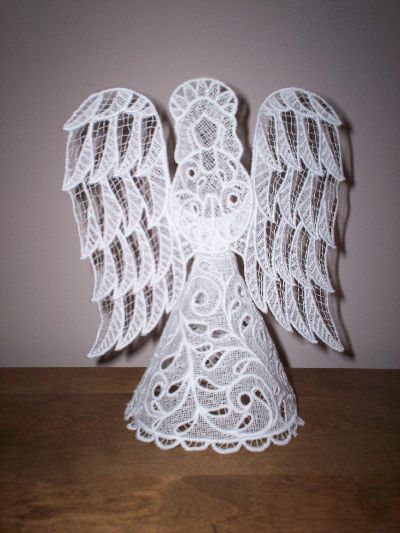
Does anyone have anyone have any particular request for new subjects on quilting? I’m still going to talk about borders, layering, quilting and finishing before I get into other things related to quilting. I hope this finds you all well and turning an impatient eye toward the end of winter, that is, SPRING.
Stitches to you,
LaRue
Quilter's Jargon
Shapes in quilting
squares
triangles
half square triangles
quarter square triangles
Quilt Police-Someone who tells you that you can't do it that way
pressing-using an iron to set the seams when making quilt blocks and quilts
pilling-migration of batting fibers through surface fabric